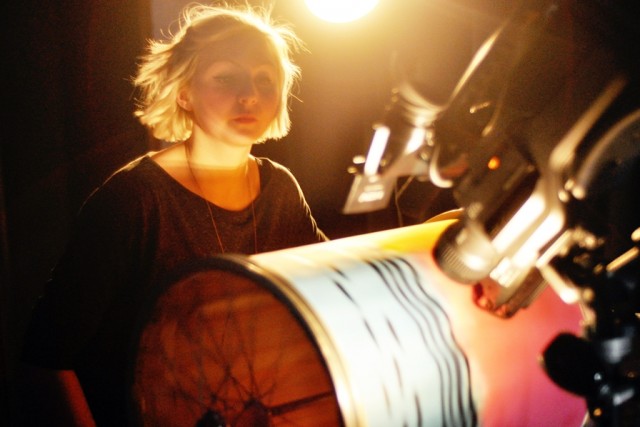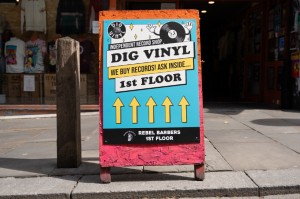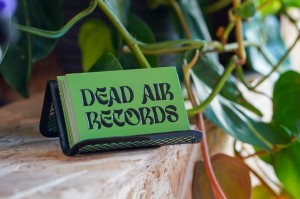Turning Drawing On Its Head: SPACE//SOUND
Maja Lorkowska takes a line for a walk with a group of innovative sound artists…
Arts and music promoters Deep Hedonia and artist-focused free sheet Drawing Paper recently got together to bring us a night of aural enchantment accompanied by real-time visuals in SPACE//SOUND. This year the event, held in the Bluecoat’s performance space, made the most of home-grown musical talent based in and around Liverpool.
In collaboration with graphic designer and Deep Hedonia founder Thom Isom, and artists Jon Barraclough and Madeline Hall from The Royal Standard studios, the evening was essentially a celebration of local creativity across different disciplines, with a twist of the electro-psychedelic. If a hundred years ago, Paul Klee was ‘taking a line for a walk’, with three-walled panoramic screens and a heap of sound equipment, the performances in SPACE//SOUND were taking it for… a rave.
Starting with the elegant Drawing Ensemble, in which musician Ria Fell performed several solo piano pieces, the audience was invited to influence the sound by drawing on ‘microphonic canvases’. Initially reluctant to join in and slightly distracted by the otherworldly sounds (including the disturbing ‘Für Elise’), we tried our hand; not only responding to the sound by mark-making, but using it to affect what we were hearing.
This thoroughly engaging idea turned a simple creative exercise on its head, essentially giving power to the drawers, who probably started off with an image idea and eventually let their hands be guided by the sound completely.
Undistinguishable Motion by Rob Strachan, Sam Wiehl (HIVE collective) and visual artist Adam Cooke was a 20-minute piece initially commissioned by the Wordsworth Trust and is a response to Book One of the poet’s Prelude collection.
Drawing on Wordsworth’s descriptions of surrounding sounds, the composition is one of fairly bleak harmonies, ranging from disjointed noise to sparse piano keys, played against high-key, monochrome clips of snow-covered landscapes. Turning us all into Romantics with melancholic tendencies, the performance managed to capture the subtle nuances of nature. Far from simply recording splashes of water, here ‘man-made’, ghostly sounds merged with those of cracking ice, a short clip of silhouetted trees projected against animated falling snow.
Resembling something of a Terrence Mallick opening sequence, this was unsettling harmony that sent shivers down my spine.
Onwards. Eating ham on-stage is not something we see everyday. But for Hot Hail (sound artist Simon Jones) it’s not a big deal. His performance, aptly entitled Ham, featured the artist using his hands and feet to operate the sound equipment whilst — most importantly — eating ham, using his mouth as an instrument, through which he aimed to “explore the hidden sounds in the world around us.”
This piece was accompanied by Jon Barraclough and Madeline Hall’s drawings projected onto the surrounding screens. Using Matisse-like instruments of pencils on sticks, the artists worked together to create a recording of their automatic responses to the sound, with squiggly lines, erased shapes and speckles of colour.
In terms of musical climax, the trio Ninetails were an undisputed highlight of SOUND//SPACE. Collaging field recordings with the more or less controlled melody of saxophone and trumpet, it was difficult to describe the eccentricity of their sound. Challenging and utterly immersive, where a momentary cacophony twisted into a melodic Hispanic harmony, with undecipherable whispers, morphing in and out of the pleasant aural disjointedness.
In the background, the sound was ‘illustrated’ using another one of Jon and Maddie’s drawing inventions – a sort of smooth-surfaced cylinder which, when in contact with a piece of graphite or colour pencil and spun manually with a side handle, allowed for the creation of unpredictable shifting marks in movement. While a fascinating tool, it was very much overshadowed by the intensity of Ninetails’ multi-layered performance.
Ending the evening on a high note was Dialect’s (Andrew Hunt) Ghost Duty, a subtle commentary about the continuously blurring lines between fantasy and reality. Further enhanced by the manipulation of ‘digital ephemera’ to generate vague sequences, leaving the viewer perplexed about what is and isn’t real, the composition was paired with video game footage taken from games like Call of Duty, using repetition and hazy imagery.
The slowly unravelling score involved sounds of slurping, crunching and military commands, ending with a delicate female speaker inviting the audience to “follow her voice”. Mildly humorous, the projected images worked in perfect (dis)harmony with the sound. For a moment we could almost make out a gruesome street-scene, which looked like documentary footage taken directly from the 10 o’clock news, highlighting the disparity between the two worlds (or perhaps the lack of it) thanks to Dialect’s skilful editing.
Afterwards, we managed to have a quick chat with Jon Barraclough, who mentioned the long and complicated preparations prior to the event, mainly involving the handmade drawing instruments. “We built them all ourselves; there is so much more potential in these machines.” Don’t worry too much if you missed them this time; there will be another 3-day event during the Liverpool Biennial this summer.
Most importantly, Jon emphasised the importance of the event as a “celebration of collaborative working”, and indeed, this is what lies at centre of SPACE//SOUND’s success. Exchanging ideas, discussion and collective experimentation drives creative thinking forward. Something to think about in our ‘selfie’-centred world.
SPACE//SOUND was, as promised, a one-of-a-kind experience, in a ‘tailor-made immersive atmosphere’. Thanks to everyone who made it happen. We’re already looking forward to the next one.
Maja Lorkowska
Images courtesy Nata Moraru and Deep Hedonia








